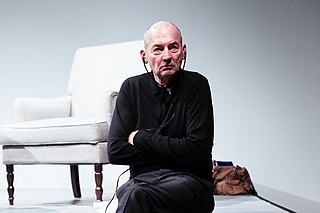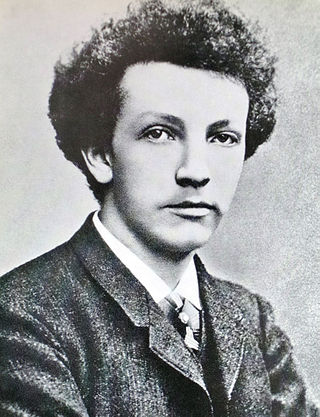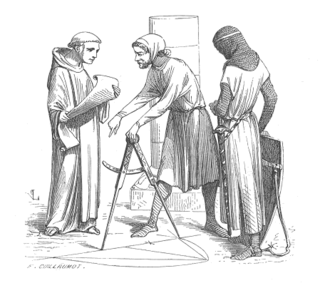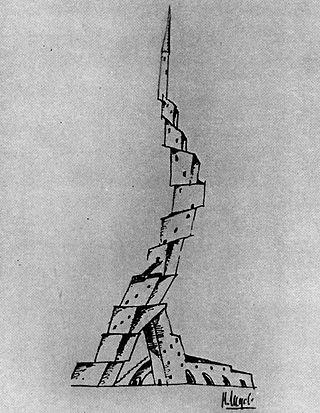Related Research Articles
Postmodernism is an intellectual stance or mode of discourse characterized by skepticism toward the "grand narratives" of modernism; rejection of epistemic certainty or the stability of meaning; and sensitivity to the role of ideology in maintaining political power. Claims to objectivity are dismissed as naïve realism, with attention drawn to the conditional nature of knowledge claims within particular historical, political, and cultural discourses. The postmodern outlook is characterized by self-referentiality, epistemological relativism, moral relativism, pluralism, irony, irreverence, and eclecticism; it rejects the "universal validity" of binary oppositions, stable identity, hierarchy, and categorization.

Remment Lucas Koolhaas is a Dutch architect, architectural theorist, urbanist and Professor in Practice of Architecture and Urban Design at the Graduate School of Design at Harvard University. He is often cited as a representative of Deconstructivism and is the author of Delirious New York: A Retroactive Manifesto for Manhattan.

In music, modernism is an aesthetic stance underlying the period of change and development in musical language that occurred around the turn of the 20th century, a period of diverse reactions in challenging and reinterpreting older categories of music, innovations that led to new ways of organizing and approaching harmonic, melodic, sonic, and rhythmic aspects of music, and changes in aesthetic worldviews in close relation to the larger identifiable period of modernism in the arts of the time. The operative word most associated with it is "innovation". Its leading feature is a "linguistic plurality", which is to say that no one music genre ever assumed a dominant position.
Inherent within musical modernism is the conviction that music is not a static phenomenon defined by timeless truths and classical principles, but rather something which is intrinsically historical and developmental. While belief in musical progress or in the principle of innovation is not new or unique to modernism, such values are particularly important within modernist aesthetic stances.

Charles Alexander Jencks was an American cultural theorist, landscape designer, architectural historian, and co-founder of the Maggie’s Cancer Care Centres. He published over thirty books and became famous in the 1980s as a theorist of Postmodernism. Jencks devoted time to landform architecture, especially in Scotland. These landscapes include the Garden of Cosmic Speculation and earthworks at Jupiter Artland outside Edinburgh. His continuing project Crawick Multiverse, commissioned by the Duke of Buccleuch, opened in 2015 near Sanquhar.

Harold Foss "Hal" Foster is an American art critic and historian. He was educated at Princeton University, Columbia University, and the City University of New York. He taught at Cornell University from 1991 to 1997 and has been on the faculty at Princeton since 1997. In 1998 he received a Guggenheim Fellowship.

Architectural theory is the act of thinking, discussing, and writing about architecture. Architectural theory is taught in all architecture schools and is practiced by the world's leading architects. Some forms that architecture theory takes are the lecture or dialogue, the treatise or book, and the paper project or competition entry. Architectural theory is often didactic, and theorists tend to stay close to or work from within schools. It has existed in some form since antiquity, and as publishing became more common, architectural theory gained an increased richness. Books, magazines, and journals published an unprecedented number of works by architects and critics in the 20th century. As a result, styles and movements formed and dissolved much more quickly than the relatively enduring modes in earlier history. It is to be expected that the use of the internet will further the discourse on architecture in the 21st century.

Kenneth Brian Frampton is a British architect, critic and historian. He is the Ware Professor of Architecture at the Graduate School of Architecture, Planning, and Preservation at Columbia University, New York. He has been a permanent resident of the United States since the mid-1980s. Frampton is regarded as one of the world's leading historians of modernist architecture.

Deconstructivism is a movement of postmodern architecture which appeared in the 1980s. It gives the impression of the fragmentation of the constructed building, commonly characterised by an absence of obvious harmony, continuity, or symmetry. Its name is a portmanteau of Constructivism and "Deconstruction", a form of semiotic analysis developed by the French philosopher Jacques Derrida. Architects whose work is often described as deconstructivist include Zaha Hadid, Peter Eisenman, Frank Gehry, Rem Koolhaas, Daniel Libeskind, Bernard Tschumi, and Coop Himmelb(l)au.

Jeffrey Kipnis is an American architectural critic, theorist, designer, film-maker, curator, and educator.

Sarah M. Whiting is an American architect, critic, and academic administrator. Whiting is currently Dean and Josep Lluís Sert Professor of Architecture at Harvard Graduate School of Design, in addition to being a founding partner of WW Architecture, along with her husband, Ron Witte. She previously served as Dean and William Ward Watkin Professor of Architecture at Rice School of Architecture. In addition to her work as an academic administrator, Whiting is most commonly identified as an intellectual figure within the field of architecture's "post-critical" turn in the early 2000s.

The Institute for Architecture & Urban Studies is a non-profit architecture studio and think tank located in Manhattan, New York, United States.
Kenneth Michael Hays is an American architectural historian and professor. He currently serves as Eliot Noyes Professor of Architectural Theory at Harvard University's Graduate School of Design. He is also co-director of the school's doctoral programs, namely Ph.D and DDes or Doctor of Design.
Rita Felski is an academic and critic, who holds the John Stewart Bryan Professorship of English at the University of Virginia and is a former editor of New Literary History. She is also Niels Bohr Professor at the University of Southern Denmark (2016–2021).

Avant-garde architecture is architecture which is innovative and radical. There have been a variety of architects and movements whose work has been characterised in this way, especially Modernism. Other examples include Constructivism, Neoplasticism, Neo-futurism, Deconstructivism, Parametricism and Expressionism.
Srdjan Jovanovic Weiss was a Harvard educated research architect from Serbia, artist and theorist living and working from New York and Berlin. He was an Ex-Head of Research of Herzog & de Meuron Architects, co-founder of School of Missing Studies for spatial research and founder of NAO.NYC for spatial design at all scales needed, based in New York.
Christophe Van Gerrewey is a Belgian architectural and literary theorist, writer and architect. He is currently tenure track professor for architectures, criticism, history and theory at the School of Architecture, Civil and Environmental Engineering (ENAC) of the École Polytechnique Fédérale de Lausanne (EPFL).
In literary criticism and cultural studies, postcritique is the attempt to find new forms of reading and interpretation that go beyond the methods of critique, critical theory, and ideological criticism. Such methods have been characterized as a "hermeneutics of suspicion" by Paul Ricœur and as a "paranoid" or suspicious style of reading by Eve Kosofsky Sedgwick. Proponents of postcritique argue that the interpretive practices associated with these ways of reading are now unlikely to yield useful or even interesting results. As Rita Felski and Elizabeth S. Anker put it in the introduction to Critique and Postcritique, "the intellectual or political payoff of interrogating, demystifying, and defamiliarizing is no longer quite so self-evident." A postcritical reading of a literary text might instead emphasize emotion or affect, or describe various other phenomenological or aesthetic dimensions of the reader's experience. At other times, it might focus on issues of reception, explore philosophical insights gleaned via the process of reading, pose formalist questions of the text, or seek to resolve a "sense of confusion."

Delirious New York: A Retroactive Manifesto for Manhattan is a 1978 book, written by Dutch architect Rem Koolhaas. The book serves as a retroactive manifesto for Manhattan between 1850 and 1960, analyzing the development of architecture and urban design throughout New York's history from the founding of New Amsterdam by the Dutch, to the design of the Headquarters of the United Nations by Le Corbusier. Rem Koolhaas describes the concept of 'Manhattanism', the theory of the creation and functioning of the city of New York, at length in the book.
Sarah Williams Goldhagen is an American author and architecture critic. Her scholarship on twentieth-century architecture, her criticism for the New Republic and Architectural Record, and her writings on the perceptual and social psychology of built environmental experience speak to architectural and urban design practices as well as the architectural history and theory of modernism. She is the author of Louis Kahn's Situated Modernism (2001), and Welcome to Your World: How the Built Environment Shapes Our Lives (2017), which the Salk Institute's Terrence Sejnowski says lays "the groundwork for a cognitive neuroscience of architecture."
Lateness is a 2020 book written by the architect and theorist, Peter Eisenman in collaboration with Elisa Iturbe, who is a professor of architecture at Yale School of Architecture. The book is edited by Sarah Whiting, the professor of architecture at Harvard University, and was published by Princeton University Press. In it, Eisenman focuses on three figures to explain the quality of lateness: Adolf Loos, Aldo Rossi and John Hejduk, each selected from a period of architecture in the 20th century. Along with this, Eisenman and Iturbe discuss the origins of the critical theory illustrated in Critical theory of Frankfurt School.
References
- ↑ Miller, Stephani (2007-08-17). "Somol to Direct UIC School of Architecture". www.architectmagazine.com. Retrieved 2023-01-14.
- ↑ Somol, Robert; Whiting, Sarah (2002). "Notes around the Doppler Effect and Other Moods of Modernism". Perspecta. 33: 72–77. doi:10.2307/1567298. ISSN 0079-0958. JSTOR 1567298.
- ↑ Lægring, Kasper (2017-05-04). "Bjarke Ingels and the Return of Representation: A Challenge to the Post-Critical". Architecture and Culture. 5 (2): 315–340. doi:10.1080/20507828.2017.1328206. ISSN 2050-7828. S2CID 194563760.
- ↑ Cowherd, Robert (2009-01-01). "Notes on Post-criticality: Towards an Architecture of Reflexive Modernisation". Footprint: 65–76 Pages. doi:10.7480/FOOTPRINT.3.1.700. S2CID 146482587.
- ↑ "Harvard Design Magazine: "Criticality" and Its Discontents". www.harvarddesignmagazine.org. Retrieved 2023-01-14.